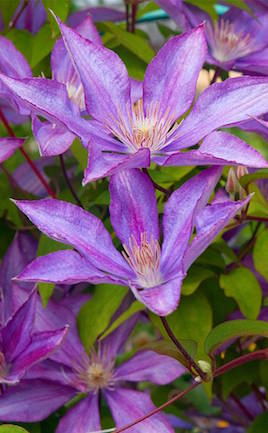- Flowers
Flower Bulbs Allium Bulbs Anemones Begonia Tubers Crocus Bulbs Daffodil Bulbs Dahlia Tubers Hyacinth Bulbs Lily Bulbs Tulip Bulbs Woodland Flower Bulbs Other Flower BulbsFlower Plants Annual Bedding Plants Children's Flower Plants Clematis Climbing Plants Cottage Garden Plants Exotic Plants Flowers For Cutting Plants Foliage Plants Greenhouse & Indoor Plants Ground Cover Plants Hanging Basket Plants Lavender PlantsHardy Geraniums Herbaceous Border Plants Heuchera Pansies and Violas Patio Plants Water Plants Window Box Plants Winter Bedding Plants Hydrangea Large impact plants Recommended By Our Experts
- Fruit & Vegetables
- Trees, Shrubs & Ornamentals
- House Plants
- Tool Shed
Garden Tools & Equipment Barrows and Trolleys Garden Solutions Harvesting Plant Supports Seed Sowing Tree Stakes Water Butts Weed Control Hand Tools Secateurs, Snips and Pruners WorkshopGarden Irrigation & Watering Irrigation Kits Water Butts Hoses & Sprays Miscellaneous Fertilisers Plant Pots Hanging Baskets Plant Protection Garden Compost All Compost
- Outdoor Living
Garden Living Barbecues & Firepits Garden Storage Solar Lights & Lighting Fixtures & Ornaments Awnings Sail Shades Garden Clocks Landscaping Lawn Edging PavingPatio Heaters Gas Patio Heaters Electric Patio Heaters Fire Pits, Chimeneas, Fire Baskets Wallmounted/Ceiling Patio Heaters Freestanding/Table Top Patio Heaters Water Features Solar Powered Water Features Mains Powered Water Features Indoor Water Features Outdoor Water FeaturesGarden Furniture Rattan Furniture Parasols Garden Benches Dining Sets Loungers Wooden Furniture Party Tents & Gazebos
- Wild Birds
- Gardening Info
- Special Offers
Join Our Gardening ClubVan Meuwen Gardening Club
Become a Member
Join our Gardening Club to unlock exciting perks and discounts!
JUST £10 for one year's membership
10% OFF EVERY order placed online £20 worth of Van Meuwen Vouchers Exclusive members only deals Join NowHow to grow clematis
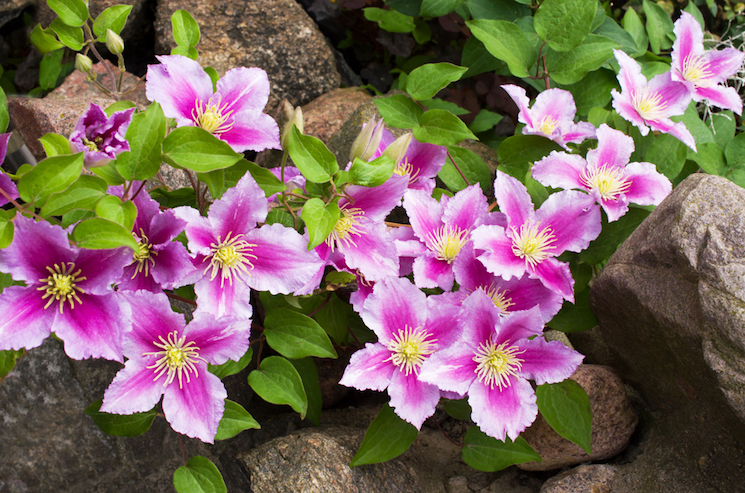
Clematis is an easy-to-grow, versatile climber
Image: ShutterstockClematis is a popular climber, grown for its huge range of flower shapes and colours. With summer-flowering and winter-flowering varieties, you can enjoy these beautiful flowers for most of the year! Equally happy in a garden border or patio container, clematis is easy to grow if you follow a few simple steps. Read on for advice about how to choose, plant, feed and prune clematis for the best show in your garden!
Three pruning groups of clematis
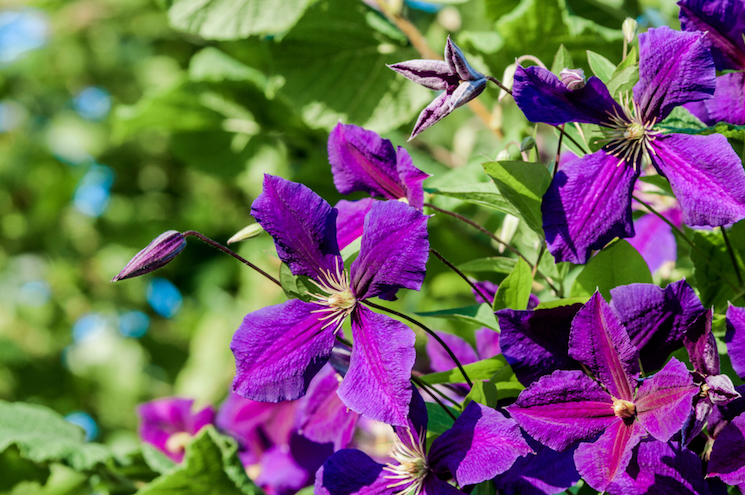
Find out which group your clematis belongs to
Image: ShutterstockClematis plants are generally divided into three main pruning groups. Knowing which group your clematis is in will help you give it the best care. Understanding the different groups will also help you choose the ideal plant for your garden, depending on whether you’re looking for spring, summer or even winter colour.
Group 1 clematis
Group 1 clematis plants are early flowering and will bloom in the winter or spring on the previous year's growth. Most evergreen clematis belong to this group and they require little or no pruning. They generally prefer a sunny and sheltered position in the garden. Many group 1 clematis are fragrant including Clematis 'Fragrant Oberon', Clematis armandii and Clematis napaulensis.
Group 2 clematis
The deciduous clematis in group 2 flower in late spring and early summer, flowering on side shoots arising from the previous year's growth. They can also flower in mid to late summer at the tips of the current season's growth. Flowers are generally larger and showier than group 1. A good example is Clematis 'Crystal Fountain'.
Group 3 clematis
This is a varying group of late-flowering clematis, including herbaceous clematis, such as Clematis 'New Love', which die back to the ground for the winter. They are mainly deciduous and flower on the current season's growth. Well known for their large, showy flowers, there also include many smaller-flowered, fragrant clematis including Clematis x aromatica and Clematis rehderiana.
Not sure which group your clematis belongs to? Use this table to work it out.Clematis is a very versatile climber and can be grown against a wall or fence, over an arch or pergola, through trees and shrubs, or in containers on the patio. Some of the early-flowering clematis varieties tend to be the most vigorous and are ideal for covering large walls, fences or old tree stumps. Smaller species and cultivars such as Clematis 'Dancing Smile' are ideal for growing in containers.
If you grow your clematis through a tree or shrub it's important to match their vigour so that the clematis doesn't swamp its host. Make sure pruning requirements are also compatible – for instance, don’t try to grow a group 1 clematis (requires no pruning) through a climbing rose (requires annual pruning).Can I plant clematis in full sun?
Clematis plants like a fertile, well-drained soil, generally in full sun or partial shade, with the base of the plant in shade. This can be achieved by under planting with shrubs or mulching around the base of your clematis with pebbles or slate chips. It's a good idea to incorporate some well-rotted manure or compost into the soil before planting to aid fertility and improve drainage.
Can I plant clematis in the shade?
Some types of clematis will tolerate shade. Varieties including Clematis ‘Frances Rivis’ and Clematis ‘Pink Fantasy’ will happily grow in the shade. Check the requirements of each variety before you buy and position clematis in your garden.
How to plant clematis
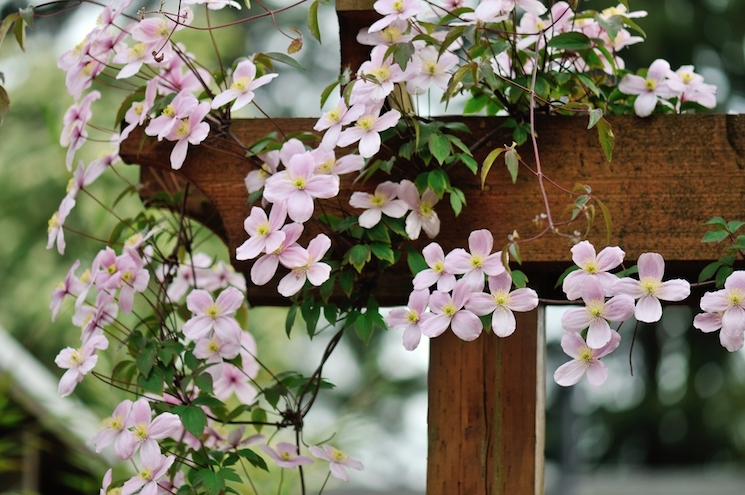
Plant group 1 varieties (such as Clematis montana) with the crown at soil level
Image: ShutterstockPlant large-flowered cultivars (groups 2 and 3) with the tops of their root balls about 5cm (2") below the soil surface. This encourages basal buds to develop below soil level and will help the plant recover if it suffers from any damage or diseases such as clematis wilt. Evergreen clematis (including group 1 clematis) such as Clematis urophylla 'Winter Beauty' should be planted with the crown at soil level.
Newly planted clematis should be pruned to 15-30cm (6-12") above ground level, just above a bud in February or March. As they mature, many clematis plants have a tendency to produce one stem with growth concentrated at the top of the plant meaning they become top-heavy. Initial training will encourage branching low down on the plant, preventing the plant producing a single stem with a tangle of heavy top-growth. You won't need to do this if the new plant already has three or four shoots growing from the base.Growing clematis in containers
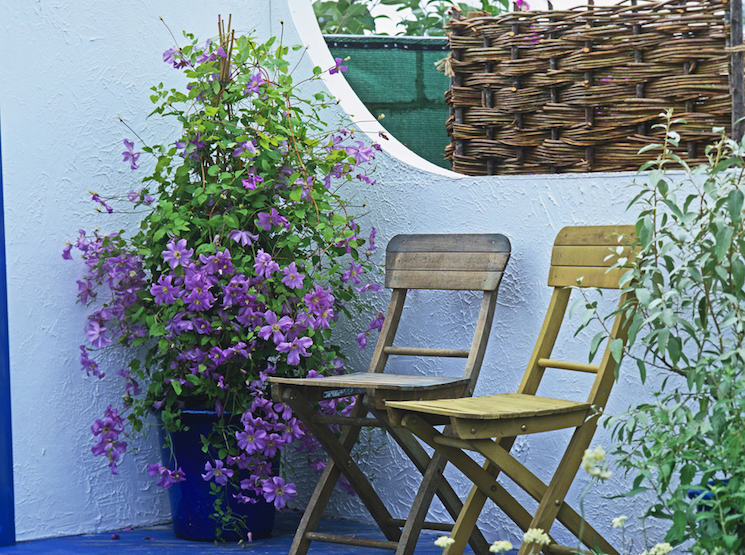
Clematis planted in containers need suitable support like this patio wall
Image: ShutterstockTo grow clematis in pots, it's best to use a large container about 45cm in diameter – with the same depth for good root growth. Make sure a suitable support is in place, such as an obelisk, small trellis or climbing frame.
Fill your container with loam-based compost, such as John Innes No. 2 or 3, rather than multi-purpose compost. Multi-purpose composts will break down over a number of years, leading to poor drainage and poor nutrient retention. Water and feed regularly throughout the summer to maintain healthy growth and encourage lots of flowers!How to care for clematis
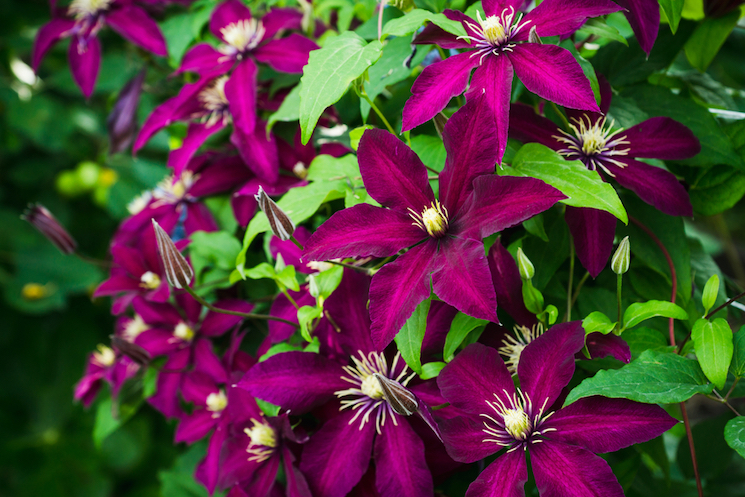
All clematis need watering in hot, dry weather
Image: ShutterstockWhether growing your clematis in the ground or in containers, here are answers to some of the most frequently asked questions:
1. How often do I need to water my clematis?
A newly planted clematis will need regular watering while it gets established. All clematis will need watering during hot, dry periods. A thorough, deep soaking once a week is better than watering little and often.
2. What kind of fertiliser should I use on clematis?
Spread a slow-release, potassium-rich fertiliser around the base of the plant, such as a rose fertiliser or specialist clematis fertiliser. Apply a mulch afterwards of organic matter such as well-rotted manure or compost. For the best flowering make sure you feed your clematis in late winter or early spring every year.
3. How can I protect clematis from slugs?
Fresh spring growth is attractive to hungry slugs. It's a good idea to put down slug barriers in early spring, especially around young plants.
How to prune clematis
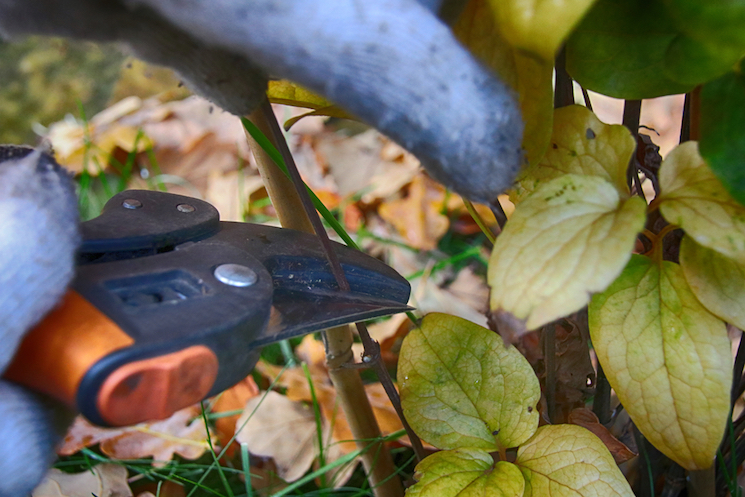
Match your pruning to the type of clematis you have
Image: ShutterstockKnowing when to prune clematis depends on the variety you have. Some clematis flower on their old wood, which must be left in place permanently, whilst others flower on new wood, so all old stems should be removed for better flowering. Pruning clematis is easy once you know which pruning group it belongs to! See the section on ‘pruning groups of clematis’ above and the accompanying product table. The pruning groups of all our clematis are also stated on each individual product page.
Pruning group 1 clematis (just needs tidying)
Clematis plants belonging to this group require little or no pruning – most winter clematis and evergreen clematis fall under this category. They produce flowers on shoots which grew the previous summer. If your clematis is growing beyond its support then it can be lightly pruned after flowering and once the risk of frost has passed in late spring.
Pruning group 2 clematis (needs light pruning)
Clematis plants in group 2 benefit from regular pruning to stimulate new shoots, which will provide late summer flowers in addition to the early summer flush. They're best pruned once in late winter or early spring, before growth begins, and again in early summer, after the first flush of flowers has faded.
In early spring, prune out any dead, weak or damaged stems, cutting back to just above a strong pair of leaf buds. Avoid heavy pruning at this stage as you may remove the early flowers.
In early summer after the main flush of flowers has finished, lightly cut back flowered stems to just above a strong pair of buds to encourage healthy new growth. This is also the time to prune overgrown clematis plants to reduce their size. Hard pruning should be carried out in stages over several years.Pruning group 3 clematis (needs hard pruning)
Clematis in group 3 make new growth from the base each year so can be pruned hard annually. Prune these clematis in late winter or early spring when buds show signs of growth.
Cut all the old stems to just above a pair of healthy buds 15-30cm (6-12") above soil level. If clematis in this group are not pruned regularly, they will develop bare lower stems with a mass of flowers too high up the plant for you to enjoy!
Don't worry too much about pruning a clematis incorrectly – you won't kill your plant, at worst you may get reduced flowering for a year.
Now you have all the information you need to ensure a happy, healthy and showy clematis, year after year. Happy gardening!
Got any top tips for growing clematis? We’d love to hear them - why not share them with the gardening community over on our Facebook page?Quick Links:
Buy clematis plants at Van Meuwen - find out more on our clematis page.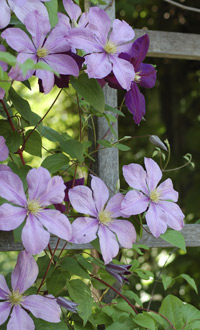
Clematis are generally divided into three main groups which helps determine their cultivation requirements.
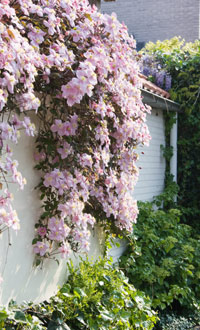
Some of the spring-flowering clematis such as Clematis montana tend to be the most vigorous and are ideal for covering large walls, fences or old tree stumps.
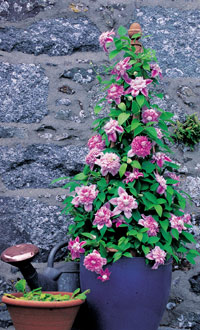
To grow Clematis on the patio it's best to use a large pot - about 45cm in diameter with the same depth, for good root growth. Make sure a suitable support is in place such as an obelisk or a small trellis.
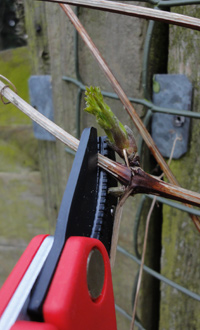
Don't worry about pruning a clematis incorrectly - this won't kill your plant and at worst you may get reduced flowering for a year!
Sign up to the Van Meuwen Gardener's Club for Special Offers
Delivery Information Privacy Policy Cookies Terms of Business Affiliate Programme Planting & Cultural Advice Contact Us© 2025 Van Meuwen. All rights reserved. A division of Branded Garden Products Limited.
- House Plants

